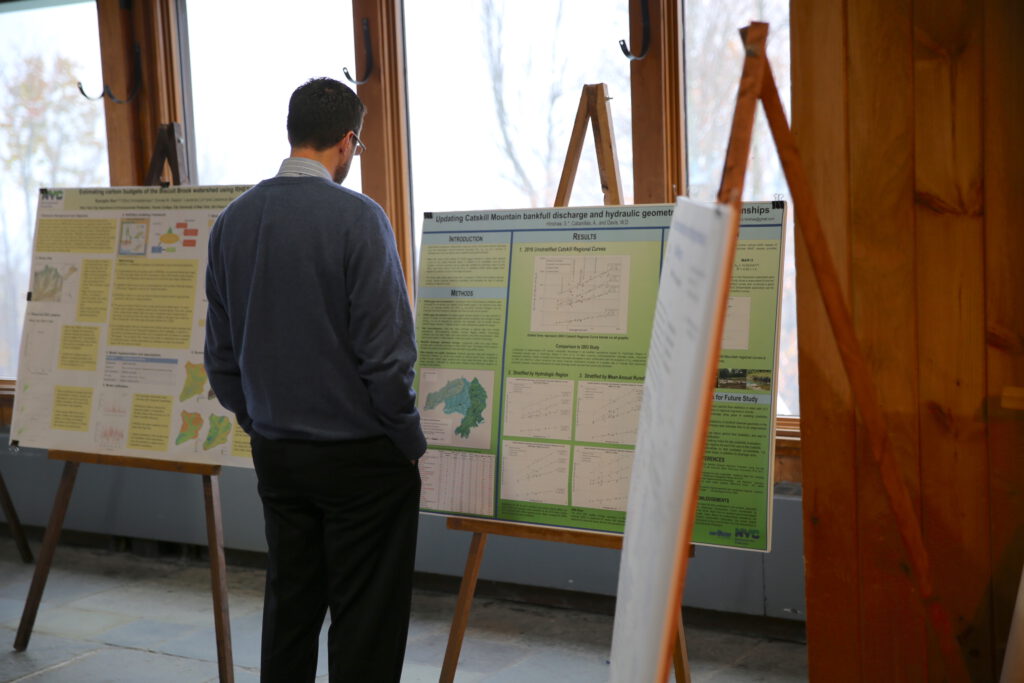
CERM 2018
The 2018 Catskill Environmental Research & Monitoring (CERM) conference was held Wednesday, October 24, 2018 through Friday, October 26, 2018. CERM 2018 featured an expanded three-day format to include field trips and a workshop, 57 platform and poster presentations, and was attended by over 160 people!
Agenda
Presentation Abstracts
Speaker Handouts
i-Tree Fact Sheet
Forest Ecosystem Monitoring Cooperative
2017 Cannonsville Tornado Salvage
Monitoring and Managing Ash (MaMA) in the Catskills
Soil/Plant Relationships for ‘Mountain High’ Field Trip
Black Bear Research in NY
iSeeMammals
Platform Presentations
Opening Remarks
Gary Lovett, Cary Institute of Ecosystem Studies, Catskill Science Collaborative
Keynote Address
Chad Dawson, SUNY College of Environmental Science and Forestry, Monitoring Impacts and Managing Recreational Use on Preserve Lands
Session 1 – Recreation Impacts
Jeff Rider, NYS Department of Environmental Conservation, Trends in Use of Public Lands in the Catskills: Management Implications
Bill Rudge, NYS Dept. of Environmental Conservation & Andy Mossey, Catskill Center, Managing Public Use at the Blue Hole: Protecting Natural Resources at a Popular Swimming Hole
John Franklin, Analysis of Human Interactions on the Lichen Diversity of Slide Mountain
Aaron Krinsky, SUNY College of Environmental Science and Forestry, Accepting Change: An Application of the Limits of Acceptable Use in Kaaterskill Falls
Session 2 – Development Impacts
Kathleen Weathers, Cary Institute of Ecosystem Studies, Salting our Freshwater Lakes
Michale Glennon, Paul Smith’s College, Make Room for Wildlife: Effects of Exurban Development on Wildlife and Lessons from the Adirondacks
Arthur Lerner-Lam, Columbia University, Fit-Bit of the Forest
Session 3 – Soil/Plant Relationships
Sam Adams, Olive Natural Heritage Society, Floristics meets Soil Science: Consilience and Collaboration in Studying Responses to Environmental Change in the Catskill High Peaks Sub-Ecoregion
Olga Vargas, USDA Natural Resources Conservation Service, Catskill Soil Taxonomy: Do the Soils of the Catskills High Peak Region Qualify as Spodosols?
Alison Keimowitz, Vassar College & Steve Parisio, NYS Dept. of Environmental Conservation, Chemistry of Special Soils in the Catskills
Chris Johnson, Syracuse University, Long-term Base Cation Weathering Rates in the Catskill Soils
Session 4 – Biodiversity
Colin Beier, SUNY College of Environmental Science and Forestry, The Fate of Forest Soil Fauna after a Century of Acid Rain: Species, Community, and Ecosystem-Level Effects
Barry Baldigo, U.S. Geological Survey, Response of Fish Communities to Changing Environmental Conditions in the Upper Neversink River: A Clean Air Act Success Story
John Wiley, U.S. Fish and Wildlife Service, Current Status of the Federally Threatened Northern Wild Monkshood in the Catskill Region: Recent Survey Efforts Show Notable Declines in this Climate-Sensitive Species
Session 5 – Sediment Studies
Jason Siemion, U.S. Geological Survey, Evaluating Suspended-Sediment Dynamics and Turbidity in the Upper Esopus Creek Watershed: A Comprehensive Study
Scott Steinschneider, Cornell University, Time-Varying Suspended Sediment-Discharge Rating Curves to Estimate Climate Impacts on Fluvial Sediment Transport in the Esopus Watershed
Scott Hamshaw, University of Vermont, Unraveling Sediment Dynamics in the Mad River Watershed through Event Concentration-Discharge Relationships and Multi-Temporal UAS Surveys
Beverly Wemple, University of Vermont, Interactions between Human and Natural Systems along Rural Road Networks: The Case of the Lake Champlain Basin
Session 6 – Hydrology
Natalie Teale, Rutgers University, Association of Synoptic-Scale Atmospheric Patterns with Flash Flooding in Watersheds of the New York City Water Supply System
Dorothy Hall, University of Maryland and NASA Goddard Space Flight Center, Use of Satellite Data to Study Lake-Effect Storms that Reach the Catskill Mountains
Donald Bonville, U.S. Geological Survey, Variations in Baseflow of a Mesoscale Mountain Catchment: Birch Creek
Ted Endreny, SUNY College of Environmental Science and Forestry, Forest Hydrology Simulation Tools for Exploring how Trees Cool Urban Runoff from Catskill Rivers
Session 7 – Long-Term Monitoring
Ali Kosiba, Forest Ecosystem Monitoring Cooperative, Introducing the Catskills Environmental Research and Monitoring Data Access Portal
Gary Lovett, Cary Institute of Ecosystem Studies, Air Pollution Success Stories in the U.S. and the Catskills: The Value of Long-Term Observations
Session 8 – Wildlife
Catherine Sun, Cornell University, Black Bears in New York State
Carl Herzog, NYS Dept. of Environmental Conservation, Bat Surveys in the Catskill Region: 10 Years and Counting
Margaret DiBenedetto, Delaware-Otsego Audubon Society, Identifying Golden Eagle Habitat Use in New York State
Jessica Best, Hudson River Estuary Program with Cornell University, American Eels and Weir Fishing in the Catskills
Session 9 – Forest Studies
Becky Shirer & Chris Zimmerman, The Nature Conservancy, Are Forests in the Catskills Region Resilient to an Uncertain Future?
Jonathan Rosenthal & Radka Wildova, Ecological Research Institute, Citizen Scientist/Land Manager Detection of Resilient Trees: A Potentially Powerful Response to Invasive Forest Pests
Deborah Layton, NYC Dept. of Environmental Protection, Growth of a Naturally Regenerating Catskill Forest 20 Years after a Catastrophic Storm Event
CERM 2012, 2014, 2016
To view presentations from past CERM conferences held in 2012, 2014, and 2016 visit this webpage.
